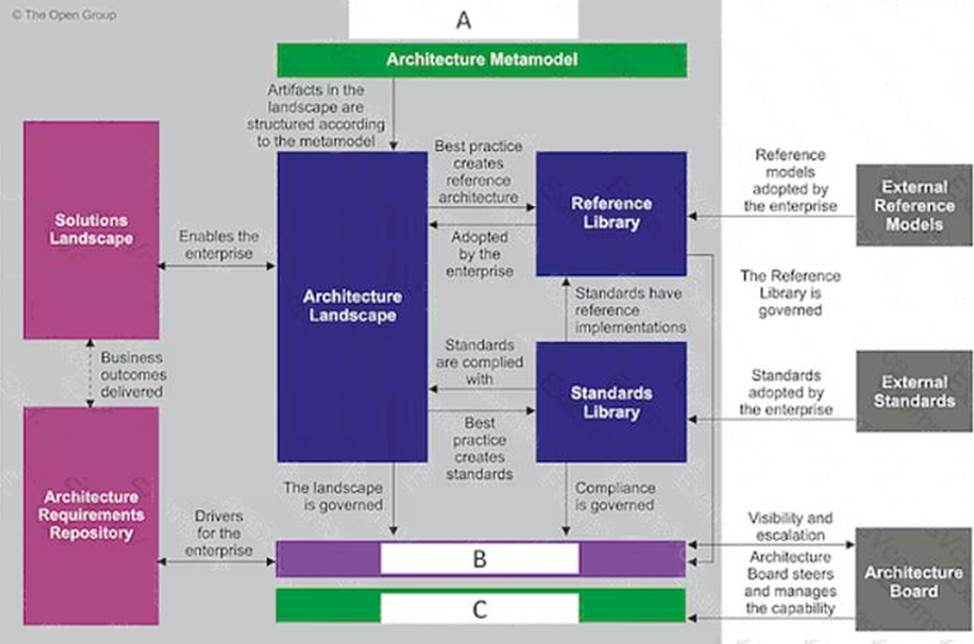The Open Group OGEA-10B TOGAF Enterprise Architecture Bridge Exam (English) Online Training
The Open Group OGEA-10B Online Training
The questions for OGEA-10B were last updated at Oct 31,2025.
- Exam Code: OGEA-10B
- Exam Name: TOGAF Enterprise Architecture Bridge Exam (English)
- Certification Provider: The Open Group
- Latest update: Oct 31,2025
Which of the following best describes the purpose of the Architecture Roadmap?
- A . It provides for effective communication of the end architecture project to the stakeholders
- B . It is sent from the sponsor and triggers the start of an architecture development cycle
- C . It forms the basis of a contractual agreement between the sponsor and the architecture organization
- D . It lists work packages on a timeline showing progress towards the Target Architecture
Which of the following best describes the purpose of the Architecture Requirements Specification?
- A . It contains an assessment of the current architecture requirements
- B . It provides a set of statements that outline what a project must do to comply with the architecture
- C . It is sent from the sponsor and triggers the start of an architecture development cycle
- D . It defines the scope and approach to complete an architecture project
Which section of the TOGAF template for Architecture Principles should highlight the business benefits of adhering to the principle?
- A . Rationale
- B . Name
- C . Implications
- D . Statement
Which section of the TOGAF template for Architecture Principles should highlight the business benefits of adhering to the principle?
- A . Rationale
- B . Name
- C . Implications
- D . Statement
Complete the sentence Business Transformation Readiness Assessment is_________________.
- A . a joint effort between corporate staff lines of business and IT planners
- B . to ensure the active support of powerful stakeholders
- C . a way to put building blocks into context thereby supporting re-usable solutions
- D . widely used to validate an architecture that is being developed
Exhibit:

Consider the illustration.
What are the items labelled A, B, and C?
- A . A-Enterprise Repository, B-Governance Repository, C-Board Repository
- B . A-Architecture Repository, B-Governance Repository, C-Architecture Capability
- C . A-Architecture Repository, B-Governing Board, C-Enterprise Capability
- D . A-Enterprise Repository, B-Board repository, C-Enterprise Capability
Which of the following best describes the need for the ADM process to be governed?
- A . To enable development of reference architectures
- B . To verify that the method is being applied correctly
- C . To enable a fast response to market changes
- D . To permit the architecture domains to be integrated
Complete the following sentence. In the ADM documents which are under development and have not undergone any formal review and approval process are_______________.
- A . Called ‘’draft’’
- B . Invalid
- C . In between phases
- D . Known as ‘’Version 0.1’’
Complete the following sentence. In the ADM documents which are under development and have not undergone any formal review and approval process are_______________.
- A . Called ‘’draft’’
- B . Invalid
- C . In between phases
- D . Known as ‘’Version 0.1’’
Complete the following sentence. In the ADM documents which are under development and have not undergone any formal review and approval process are_______________.
- A . Called ‘’draft’’
- B . Invalid
- C . In between phases
- D . Known as ‘’Version 0.1’’
Latest OGEA-10B Dumps Valid Version with 104 Q&As
Latest And Valid Q&A | Instant Download | Once Fail, Full Refund

